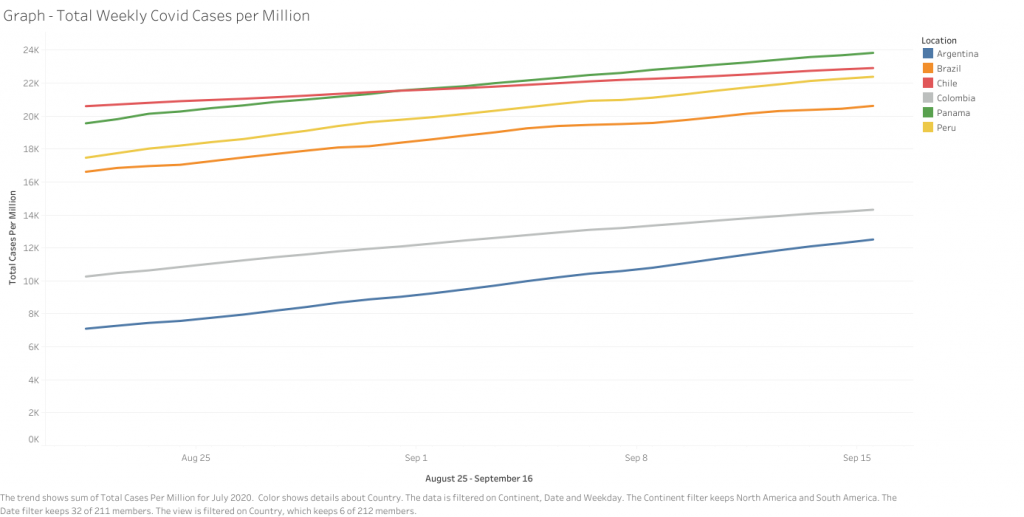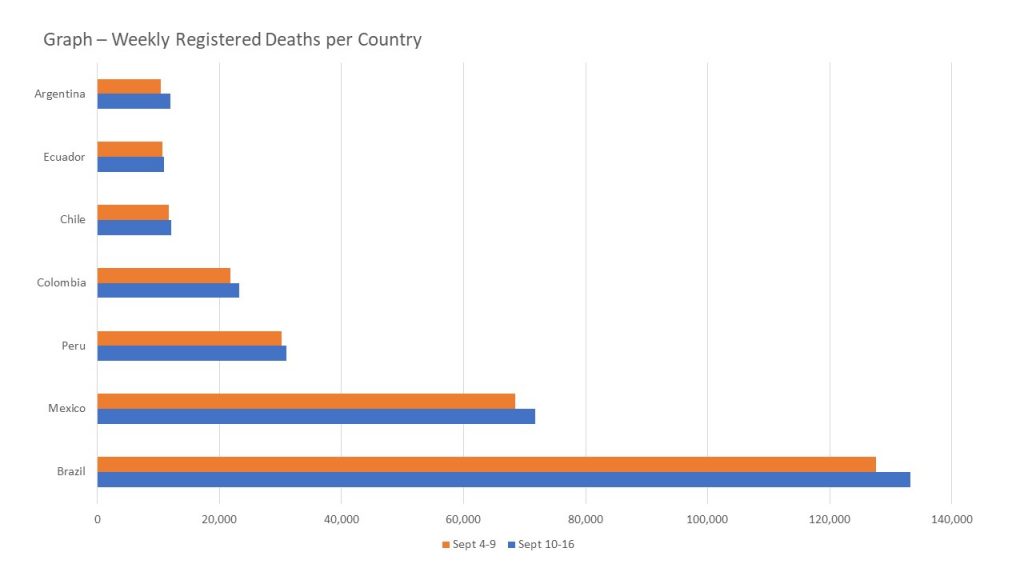What you should know
- On September 13, the World Health Organization reported the highest one-day increase in COVID-19 infections since the start of the pandemic, reporting more than 308,000 new cases globally. Brazil reported the third-highest daily increase after India and the United States, with 43,718 new cases. Brazil, Peru, Mexico, and Colombia, all rank among the top-10 countries for reported coronavirus cases.
- Latin American governments’ efforts to reduce deficits and debt will be hindered by expenditure rigidities and a limited ability to increase taxes, according to a new report from Fitch Ratings.
- The COVID-19 pandemic has given a prominent role to police officers and the military in Latin America, with armed forces deployed in Brasil, Mexico, Ecuador, Peru, Bolivia and Colombia to supposedly help control the spread of the virus.
By the numbers
- Cases by country: Brazil (4,384,299) #3 worldwide, Peru (738,020) # 5 worldwide, Colombia (728,590) #6 worldwide, Mexico (676,487) #7 worldwide, Argentina (577,338) #10 worldwide, Chile (437,983) #11 worldwide, [view full list]
- Prevalence rate (total cases per million people): Aruba (29,496) #3 worldwide, Panama (23,756) #5 worldwide, Chile (22,871) #6 worldwide, Peru (22,319) #8 worldwide, Brazil (20,596) #10 worldwide, Turks and Caicos (16,742) #16 worldwide, [view full list]
- Deaths – total reported in the region: Brazil (133,207) #2 worldwide, Mexico (71,678) #4 worldwide, Peru (30,927) #8 worldwide, Colombia (23,288) #11 worldwide, Chile (12,040) #14 worldwide, Argentina (11,910) #15 worldwide, [view full list]
Join us as World Leaders Virtually Meet: Latin America and the Caribbean at UNGA 75, a Two-Day Series
- Day 1: Leaders will virtually convene at UNGA 75 amid a global public health crisis and economic contraction. Join us on September 23 for a discussion on how to accelerate international cooperation with the region amid the COVID-19 pandemic.
- Day 2: On September 24 Interim President Juan Guaidó will speak at an Atlantic Council special event that will put a spotlight on Venezuela’s continued democratic struggles as elections near.
Quarantine + reopening plans
With COVID-19 cases on the rise, some governments have chosen to extend restrictive measures.
- Cuba extended the nightly curfew in Havana until September 30. The curfew, which began September 1, prohibits citizens from circulating from 7:00 PM until 5:00 AM.
- Chilean President Sebastian Piñera announced the government would extend the state of emergency for 90 days from September 15, backtracking on a previous announcement that the state of emergency would be extended only for two weeks.
- Honduras extended its national curfew, which began in April, until September 20.
- Venezuela’s Maduro announced face-to-face classes would not resume until 2021 and lessons would be offered online and on state TV.
Other countries have continued to gradually reopen, seeking to reactivate their economies after months.
- On September 12, Ecuador’s state of exception order expired, lifting federally-mandated curfews and limits on vehicular circulation. However, many local authorities, including the mayors of Quito and Guayaquil, have implemented new restrictions. The order had been in place since March 16.
- Beginning September 15, the Dominican Republic no longer requires visitors to present a negative PCR test to enter the country. However, visitors will be subject to randomized COVID-19 breath tests.
- On September 14, Panama eliminated gender-based restrictions and reduced its curfew to 11:00 PM to 5:00 AM, continuing its gradual reopening plan announced at the end of August.
International travel restrictions
- El Salvador will resume international commercial flights beginning September 19 after a six-month suspension.
- Guatemalan President Alejandro Giammattei issued a presidential degree allowing international flights to resume on September 18.
- The State Department lowered its travel advisory for Mexico from Level Four – do not travel – to Level Three – reconsider travel – before the border closure restricting nonessential land travel expires on September 21.
Economies in focus
Economic impact
- Argentina’s draft budget sets the ambitious goals of a fiscal deficit of 4.5 percent of GDP in 2021 and an economic rebound of 5.5 percent.
- Economic activity in Brazil grew 2.2 percent in July, falling short of the anticipated 3.4 percent.
- The Chilean Central Bank confirmed the economy had stabilized after historic decreases in the second trimester.
- Mexico’s GDP contracted 17.1 percent during the second trimester according to the OECD – following India and the United Kingdom, the third worst contraction among the G20.
- The Peruvian economy contracted for the fifth consecutive month, falling 11 percent in July. However, the contraction is less severe than previous months; -18 percent in June and -32 percent in May.
Economic relief
- Bolivian Minister of Economy Oscar Ortiz announced the government had requested a credit line of $203 million from the Development Bank of Latin America (Corporacion Andina de Fomento — CAF) for municipal and departmental governments’ response to the COVID-19 pandemic.
For the Latest Global Economy News: The Atlantic Council’s Global Business and Economics Program produces a weekly, invitation-only financial note. If you would like to join the list, send an email to request an invitation.
Health + innovation
- After an international pause on all AstraZeneca-Oxford University COVID-19 vaccine clinical trials early last week, the company restarted vaccine trials on September 14.
- Despite this setback, Chile’s Minister of Health announced that the country will ensure access to a COVID-19 vaccine in the first quarter of 2021. The vaccine will be free for all residents and will first be administered to high risk groups.
- Other Phase III clinical trials continue to move forward in Latin America, increasing the chance that a vaccine is proven viable in the region.
- Russia announced that Mexico will receive 32 million doses of the Sputnik V COVID-19 vaccine.
- Peru began Phase III clinical trials of the Sinopharm COVID-19 vaccine on September 9 with 3,000 patients.
- A team of scientists led by a senior researcher at the National Council for Scientific and Technical Research of Argentina is studying a potential oral vaccine for COVID-19. The drug is in the preclinical phase and results have, so far, been promising.
- On September 10, Brazil announced that it will work with Australia’s Murdoch Children’s Research Institute on a project to establish whether the tuberculosis vaccine could also be effective against COVID-19.
A Message from PhRMA: Today, there are several promising vaccine candidates in stage three clinical trials. These trials have tens of thousands of participants, from every walk of life. From development to robust clinical trials, and throughout manufacturing, these vaccine candidates folllow the same rigoruos process of other vaccines that have saved millions of life. More.
Country Focus
- Argentina: Argentina passed Chile to claim the 10th spot in most cases globally, with 417,75 infections and 8,730 confirmed deaths. From August 25 through September 1, cases rose by 9.9 percent, the most among the top 20 countries.
- Brazil: In August 2020, the number of fires in the Brazilian Amazon was the second highest in a decade, nearing the crisis levels of 2019. In the Amazonas state, indigenous communities remain the most at risk of contagion and extinction, due to a lack in immunological protection and living without basic sanitation facilities and far from healthcare facilities.
- Colombia: The Colombian government announced new tax incentives for companies from Asia, Europe, and Latin America that are looking to relocate to the Andean nation. The initiative is part of a broader plan to attract $11.5 billion in non-hydrocarbon related foreign direct investment a year by 2022. The government is also focused on new investments to push job creation, with the pandemic having caused the unemployment rate to spike to almost 25 percent.
By the numbers (continued)
- Cases by country (continued): Bolivia (117,267), Ecuador (114,309), Dominican Republic (94,979), Panama (93,552), Guatemala (74,893), Honduras (61,769), Venezuela (47,756), Costa Rica (42,184), El Salvador (25,904), Source: worldometers.info
- Prevalence rate (continued): Argentina (9,460), Domincan Republic (8,741), Costa Rica (8,268), Suriname (6,960), Ecuador (6,463), Honduras (6,220), Bahamas (5,778) Mexico (4,692), Guatemala (4,168), El Salvador (3,990), Source: worldometers.info
- Deaths (continued): Bolivia (5,101), Guatemala (2,778), Panama (2,018), Honduras (1,888), Dominican Republic (1,738), El Salvador (731), Costa Rica (443), Venezuela (391), Paraguay (231), Nicaragua (137), Cuba (91), Uruguay (43), Belize (10). Source: worldometers.info
Quick take


